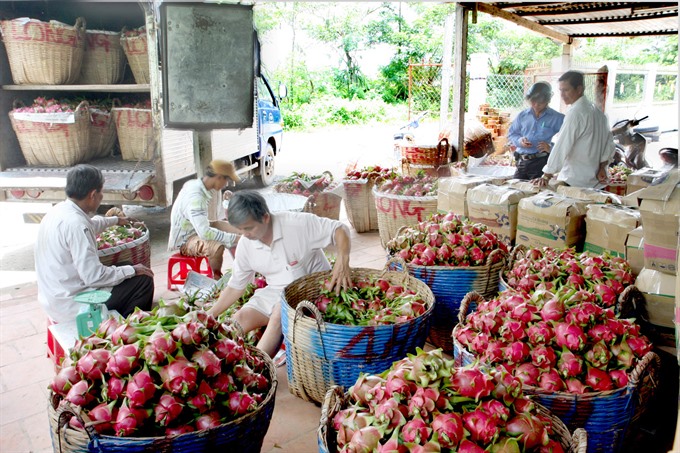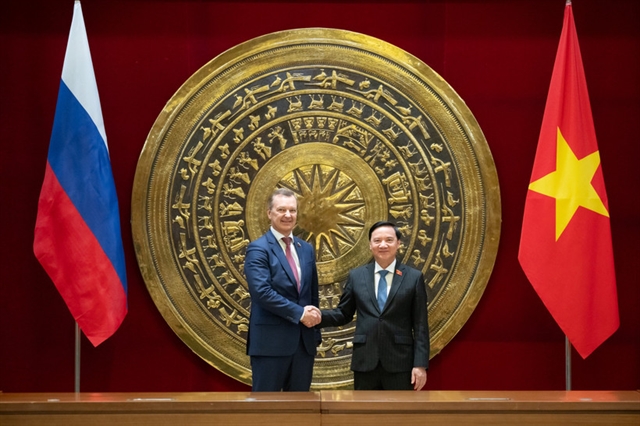 Politics & Law
Politics & Law

Việt Nam’s agricultural production not only met domestic demand, but was exported to 180 countries, Minister of Agriculture and Rural Development Nguyễn Xuân Cường told the National Assembly meeting in Hà Nội yesterday.
 |
| Farmers in Quơn Long Commune, Chợ Gạo District in southern province of Tiền Giang pack green dragon fruit. NA deputies suggest using fruits, flowers and vegetables to spearhead exports.— VNA/VNS Photo Đình Huệ |
HÀ NỘI – Việt Nam’s agricultural production not only met domestic demand, but was exported to 180 countries, Minister of Agriculture and Rural Development Nguyễn Xuân Cườngng told the National Assembly in Hà Nội yesterday.
Cường said that in 2016, agricultural exports amounted to US$30 billion, and were expected to reach $35 billion this year.
He said while climate change brought many challenges for agricultural production, they could be tackled by reforms in the sector, citing the fact that the Mekong Delta region had shifted from growing rice, fish and fruit to producing more fish and fruit.
“The demand for fishery products grows from five to seven per cent each year. Việt Nam has chosen its strength in providing shrimps and tra (cat) fish, and we still have huge potential,” he said.
Regarding fruit exports, the minister said each province should invest in its own signature type of fruit, for instance flowers in Đà Lạt City, longan in Hưng Yên Province and oranges in Cao Phong District of Hòa Bình Province.
“The weather in Ninh Thuận Province is rather hot and dry, but apple and grapes grown in this province are very tasty. So it’s obvious that if we choose the right crops, we can make huge profits,” he said.
Sharing Cường’s opinion, Deputy Nguyễn Thiện Nhân from HCM City, said recent statistics showed that the total export value of fruit, flowers and vegetables had exceeded that of oil exports.
In 2016, Việt Nam raised $2.4 billon in oil exports. Rice exports were valued at $2.15 billion, coffee exports at $3.5 billion, fishery exports at $7 billion, and fruit, flowers and vegetable at $2.45 billion.
In 2005, oil exports were $7.3 billion, 31 times higher than fruit and vegetable exports at that time, which was only $235 million.
Thus, Nhân suggested using fruits, flowers and vegetables to spearhead exports.
“It is forecast that fruits, vegetable and flowers exports will reach $9 to 10 billion in 2022,” he said.
Losing projects
Explaining 12 projects under the management of the Ministry of Trade and Industry, minister Trần Tuấn Anh said dealing with these project was following the right progress.
The ministry’s statistics showed that 12 projects incurred total losses of over VNĐ16 trillion as of the end of 2016 on investments of VNĐ63.6 trillion, with loans accounting for roughly 75 per cent.
The 12 inefficient projetcs include Ninh Binh Fertilizer Plant, DAP 2 Haiphong Fertilizer Plant, Lào Cai DAP 1 Fertiliser Plant, Hà Bắc Fertilizer Plant, Phương Nam Pulp Mill, and Dung Quất Shipbuilding Plant, three ethanol projects in Quảng Ngãi, Phú Thọ and Bình Phước provinces, Đình Vũ Polyester Plant, Thái Nguyên Steel plant and Iron Plant and Quý Xa iron ore mining.
In 2016 and 2017 the Government set up steering committees to work on the projects, which were operating ineffectively. The preparation for measures will be completed in 2017 and in 2018 these meaures will be enforced aggressively, Tuấn Anh said.
“Such complicated work will take a long time. We would have to make an overall assessment to find solutions. The important thing is the lessons learned from the failure of these projects,” he added.
The latest report by the trade ministry said that six factories out of the 12 projetcs were still operating, but suffering loss, including four factories producing fertiliser, the Dung Quất Shipbuilding plant and Việt Trung Steel plant.
Three other projects, including the Phú Thọ ethanol project, Thái Nguyên Steel Plant and Phương Nam Pulp Mill, had been suspended due to shortage of capital.
“Four fertiliser factories have been recovered and starting to re-operate, three other projects making bio-ethanol gas are being re-organised and will operate again in 2018,” he added.
Regarding the issue of ineffective management to stop cigarettes smuggling, Tuấn Anh admitted that the matter was troublesome.
“It’s true that some smuggling rings are not afraid of the law. Many rings are well-organised and operating systematically not only in one locality, but on a much larger scale," he said.
Tuấn Anh admitted inspection teams in public security and market management were not working effectively.
In future, individuals caught smuggling more than 1,500 cigarettes will be subject to criminal law, he said.
Logistic services
Regarding logistics services, deputy Nguyễn Quốc Bình from Hà Nội cited data from the Ministry of Industry and Trade and the Việt Nam Business Logistics Association that the value of Việt Nam’s logistics market is equal to 21-25 per cent of the country’s GDP.
Logistics services are an important economic sector with potential in the country. This industry can boost GDP growth and the economy’s competitiveness, he noted.
He pointed that the logistics industry’s contribution to the economy remains modest, only about 2-3 per cent of total GDP. Logistics are considered a lucrative but untapped sector in Việt Nam because some 80 per cent of the logistics market is run by foreign firms.
While logistics costs are estimated at 7-15 per cent of GDP in developed countries, they account for 21-25 per cent of Việt Nam’s GDP, hampering growth. Therefore, it is important to reduce logistics costs while improving services, he stressed.
Highlighting advantages for logistics services development, Bình said Việt Nam is located in the centre of the Asian-Pacific region in terms of maritime and air transportation. It is a gateway to the East Sea, one of the world’s busiest shipping lanes, for three of the four economic corridors in the Greater Mekong Sub-region. It also has locations favourable for building deep-water seaports and international transit airports.
The deputy said logistics can become a spearhead sector in Việt Nam’s economy, and the country should work harder to optimise its advantages.
Health problems
In the afternoon session, health minister Nguyễn Thị Kim Tiến discussed matters of public concern to voters.
Regarding this year’s long-lasting dengue fever outbreak, she said the number of cases was 40 per cent higher than last year.
"Climate change, prolonged hot weather and lots of rain were the main reasons for the outbreak," she said.
The health minister said that the rate of people with health insurance is currently 82 per cent, higher than the target assigned by the National Assembly and the Government.
The health insurance surplus by the end of 2016 was VNĐ47 trillion (US$2 billion).
"Is that good? It might not be good because it means the health insurance funding has not been used up for people who need better services," Tiến said.
However, she said the funding can be used if spending on health insurance fund this year exceeds VNĐ10 trilion ($440 million).
During the day, NA deputies also talked about defence and security issues; natural disaster prevention and response, climate change response; environmental protection issues in export processing zones and industrial zones. Other matters of concern regarding social issues were searching for the remains of martyrs; caring for the elderly; care and protection of children; wage reform and State administrative reform.—VNS




